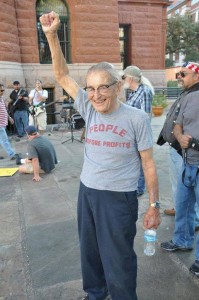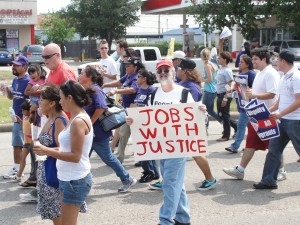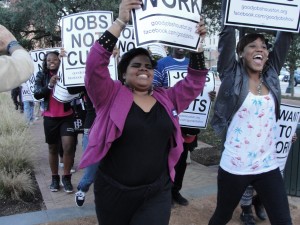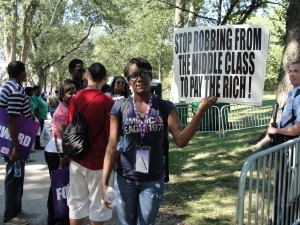By Patrick Snipes

John Stanford
A speech delivered on November 29, 2013 at a rally of WalMart workers in Durham, North Carolina also reported at:
http://www.counterpunch.org/2013/12/02/my-years-at-wal-mart/
WalMart: The rising tide that drowns the workers while the owners sail their yachts
Hi, I’m Patrick. I’m a former Wal-Mart deli sales associate from store #2137, where I worked for about two and a half years. Firstly, I would like to give thanks to my mother, who is currently a Wal-Mart associate, and to all other Wal-Mart associates who’re working today and were kept from their families yesterday. When I was asked to speak here today, I was a bit taken aback; I haven’t done any public speaking since high school and wasn’t entirely sure what I should talk about. So, let’s start with a simple fact, nothing more, nothing less. The six Wal-Mart heirs (Christy Walton, Jim Walton, Alice Walton, S. Robson Walton, Nancy Walton Laurie and Ann Walton Kroenke) hold more wealth than the bottom 42% of Americans put together. Now, let’s do some math! The population of the United States is about 314 million. 42 % of that is 131.88 million people. Divide by 6 and you get 21.98 million. What this means is that for every dollar the average person in the lower 42% of the country has, these 6 people have, on average, 21.98 million dollars. As easily as you or I can buy a Kit-Kat, they can buy a custom-made 145 foot yacht and still have 2 million leftover. Please keep this fact in mind as I continue.
And… now I’m unsure again as to what I should talk about. After 2 years and 7 months there are a great many things. I could talk about how my family didn’t have Thanksgiving yesterday because my mother was at work. I could talk about schedules which left me running the deli single-handed from 4 PM to 11, essentially asking me to do 30 man-hours worth of work in 8 as though I were blessed with 7 arms. I could talk about how similar schedules were in no way uncommon, once 4 times in a single week, and how, when I approached management (even going so far as to show them the schedule for a few days out and asking that they fix it), my complaints fell upon deaf ears; the schedules remained unchanged. How the flip-side of this under-staffing was hours-cuts which left me earning the equivalent of 9,000 $/year, for months on end, and forced me to choose between paying my bills on time or having food. How I saw my co-workers, who rode the bus to get to and from work everyday, who have children whom they love and want to spend time with, get off work at 11 o’clock at night just to come back the very next day at 7 in the morning. And how, despite all that, they still had to be on food stamps to feed their kids because we were paid so little. About how one of our cart-pushers came down with a severe case of the flu and, for forgetting to call-out during ONE of the days he spent in the hospital, got fired. How one of my co-worker from the deli was fired on her very last day at Wal-Mart, after they had no more use for her, for having forgotten one day to pay for a meal plate worth 3 dollars and 50 cents three months prior; she’d signed a new lease earlier that day, but termination for theft caused her to lose her new job and forced her to move back in with her family in Florida. Later that night I was required to throw away hundreds of dollars worth of food. About how, at my mothers store, an Assistant Manager, offended that one of his underlings, and a woman no less, had the gall to speak back to him, conspired to get rid of a zone-manager, a diabetic, while she was out on medical leave for her second heart-attack; she was demoted to part-time cashier and lost her medical coverage. He was promoted to co-manager.
But… any single one of these things, perhaps even all of them since they’re drawn from merely 2 stores, might, by the limitation of their scope, play into the very narrative Wal-Mart wants its workers to believe. “These are isolated cases of improper managementâ€, they might say, “which can be dealt with by the open door policy.†The same open door policy which was put forward to us on the very first day of orientation as the reason we do not need a union. Also, not one of those things really captures how impersonal an experience it is to work at Wal-Mart, a store which tracks its workers comings and goings down to the minute by their barcode. A store so impersonal that, in order to call-in sick, its workers must dial a 1-800 number, identify themselves by their eight-digit birthday, the last four digits of their social security number and their four digit store number followed by the pound key, and then press 1 to indicate they’re calling to report an absence, 1 to indicate that absence is for today, any number 1-5 for reasons ranging from personal illness to natural disaster, only to get a 10 digit confirmation number and be re-routed to their store, where they’re expected speak with a salaried member of management before getting off the line, itself a process that can take upwards of 20 minutes. And a store which, after hiring me on September 11th 2010, thought it a good idea, on September 11th 2011 and September 11th 2012, to display a message on the time clock which read “Happy Anniversary!â€.
But again I can hear the corporate response already. They might say something like: “These precautions are necessary for maintaining operations on the scale of Wal-Mart, the world’s largest retailerâ„¢, and in no way reflect upon Wal-Mart’s respect and consideration for its associates.†If only I had something which could fuse together the deeply personal grievances I hold against my previous employer with the cold, impersonal way it seemed to regard me. Oh wait… I do! In the back-room at my store, tossed in among a maudlin mix of motivational posters (ya know, the kind they make fun of on the internet), was this one poster which obviously came down from corporate on high. On the top it read “Wal-Mart’s Model for Success,†and below it had this little circular flow-chart surrounding an image of a cashier happily working, grinning the sort of wide, iridescent smile we’ve all come to expect of folks who work part-time for minimum wage, at a job which always charts their productivity according to scans-per-minute but provides no dental coverage. And this little flow-chart, in which this Cheshire-Cashier found herself encased, was broken down into four parts which read: “Buy for Less,†“Sell for Less,†“Grow sales†and, ultimately, “Reduce Operational Costs.†And when I saw that I said to myself: OH. NO. YOU. DID. NOT! Just call me, my mother, and my co-workers, loving mothers to their own children, OPERATIONAL COSTS to be reduced ad infinitum in the endless cycle of YOUR success. And that, right there, posted on the wall for all to see, yet masked with kindly imagery and sanitized corporate phraseology, is the logic at work behind it all. And it is that logic which can never be changed by any “open door policy†however perfectly implemented, but which CAN be changed by an association of associates standing together to say as one: We are human beings, not numbers and we will not stand idly by while you seek to subtract, from us, our livelihoods! And now I’m, briefly, going to go through these steps to demonstrate what they really are: a depraved diminution of the human soul into the mere fuel which drives a great engine of profit.
Step 1: Buy For Less
To see this step, you have to go all the way to the other side of the globe. For only distance is capable of providing a veil thick enough to obfuscate its moral reprehensibility. On November 24th 2012, the Tazreen Fashions factory in Dhaka, Bangladesh, which was creating goods for Wal-Mart stores, caught fire killing at least 117 people. They were locked inside. The building had no fire exits and the windows were barred. Those who escaped did so by kicking out exhaust fans and leaping onto the roof of an adjacent building. For the injuries they incurred, some of which rendered young, able-bodied people incapable of ever walking again, they have received no compensation, nor have the families of those lost in the fire. Five months later, Rana Plaza, a massive building housing 8 garment factories collapsed, killing 1,129 and injuring 2,515. And it was against practices such as these, that the late Reverend Dr. Martin Luther King, in one of his less publicized quotations, once said: “A true revolution of values will soon look uneasily on the glaring contrast of poverty and wealth with righteous indignation. It will look across the seas and see individual capitalists of the West investing huge sums of money in Asia, Africa, and South America, only to take the profits out with no concern for the social betterment of the countries, and say, ‘This is not just.'”
Step 2: Sell For Less
I find this step somewhat curious. After all, wouldn’t a business want to sell for more? The key is how this step flows into the next, “Grow Sales.†In this, the step reveals itself as being “Sell Less than the Competition.†Wal-Mart uses its ability and willingness to leverage its foreign producers into producing goods at “everyday low prices,†without regard to the “everyday squalid conditions†of their workers, as a weapon against other domestic businesses which are unwilling or unable to do the same. Thus, it consolidates our commerce into fewer and fewer stores.
Steps 3 & 4: Grow Sales and Reduce Operational Costs
I’m going to tackle these two steps together, because they are seemingly contradictory. A growth in sales would increase the size of the operation, and would thus seem to point toward “Increase Operational Costs†as opposed to its opposite. But, though these two steps may not flow into one another as sensibly as their predecessors, together they point toward an ideal, a dream, a fantasy which seems to motivate Wal-Mart. Namely, the idea of an infinitely productive worker. If they can make one do the work of two, they will. If they can make one do the work of three, they will. Trust me, they made me do the work of three and a half! Hell, if they could get one guy to run the whole store, they’d do it in a heart-beat. And if they could pay that guy minimum wage, they’d do that too! All the while, lobbying our government to let that minimum wage atrophy. These steps, taken together, expose the impetus behind the overwork and under-pay of Wal-Mart’s domestic workers, and it calls into question whether or not this too is a country from which profits are taken with no concern for social betterment.
And I would like to wrap this up by posing a question: If the entire economy was made up of such businesses, an economy of businesses all pushing production abroad to wherever people can be maximally exploited, an economy consolidated into as few stores as possible, an economy of stores which pay workers little as they can and which operate with as few as they can, what would that look like? And how long would it take to crash? Make no mistake, Wal-Mart is not alone in this. Its model serves as a model for a great many others. Wal-Mart is but the largest wave in a rising tide, and, unless we stand together, united and with dignity, as a great levy for justice to hold and push it back, this tide threatens to drown us all. Except, of course, for those among us who can afford custom-made, 145 foot yachts. Thank you.

Occupy Houston supporters on 11/17/11
















